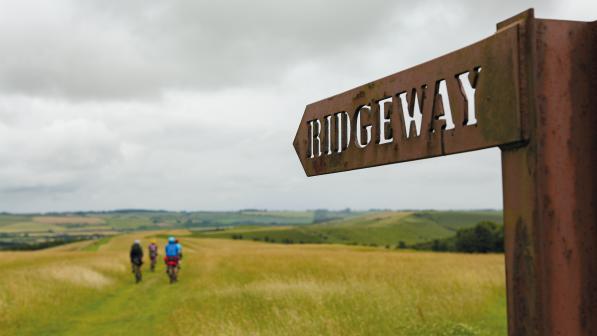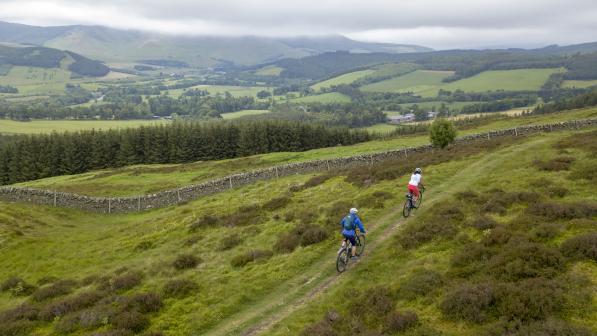Public Footpaths (England & Wales)
By Cherry

Some footpaths (l) are better for cycling than some bridleways (r)
Headline message
Please note this briefing is out of date and due to be revised. For advice on off-road access for cycling, see our guidance on Where can I cycle off-road?.
- Opening up much more of the Rights of Way (RoW) network in England and Wales would be of enormous benefit for the healthy and environmentally friendly activity of cycling, both for recreation and day-to-day travel.
- Whether a legal right exists to cycle on a RoW does not necessarily relate to how suitable it is. Many footpaths are better for cycling than many bridleways (see photo above) – but, in law, cyclists are only permitted to use the latter. From a cyclist’s point of view, therefore, this often makes the RoW network incoherent, illogical and frustrating. This is a problem that can only be sorted out through legal reforms and political will.
- Even within the current laws, though, there are many ways in which local authorities could open up more paths for cycling.
Policy key facts
- Cycling is legally permitted on less than a quarter of the Rights of Way network in England and Wales; in contrast, Scotland’s Land Reform Act (2003) opened up most of the Scottish countryside to cyclists, as long as they abide by an access code.
- England has 146,000km of public footpaths, and Wales more than 26,000km. These are mostly rural rights of way specifically restricted to pedestrians and the right to walk along them is legally protected. If most English footpaths were opened up for cycling, it could more than triple the mileage currently available to cyclists in the countryside.
- Unless the landowner permits it, cycling on a footpath in England and Wales normally constitutes trespass, making it a civil but not a criminal matter. A local by-law or Traffic Regulation Order (TRO) covering a particular footpath, however, can make it an offence.
- Although there is no legal right to cycle on footpaths, some are regularly used by cyclists. If enough cyclists and/or other users such as equestrians use a footpath in this way without the landowner challenging them for (usually) 20 years, then a bridleway or a restricted byway may be claimed through ‘presumed rights’ under s31 of the 1980 Highways Act.
Cycling UK view
- The public footpath network offers the only realistic option for providing significantly more off-road routes to meet current and future demands. The Scottish Land Reform Act (2003) gave cyclists lawful access to most countryside in Scotland. Its success suggests that public footpaths in England and Wales could be similarly opened to cyclists as a simple remedy to overcome the lack of off-road routes for cyclists and the fragmented nature of the available route network.
- Rights of way laws should be amended to permit cycling on footpaths with few limited exceptions only where there are clear location-specific reasons not to do so (for example, where the increased use of the path would create significant environmental or safety hazards).
- Conflict on rights of way between cyclists and pedestrians is often more perceived than real. It can be mitigated by good design.
- Cycling UK believes that it is acceptable for cyclists to use footpaths, provided they do so in a manner which respects the safety of other path users and their peaceful enjoyment of the outdoors, and with regard for the environment and its ecology. These are the circumstances in which Cycling UK believes it is acceptable for cyclists to ride on footpaths:
- Where the surface and width of the path make it eminently suitable for safe cycling without causing disturbance or risk to pedestrians
- Where the path is lightly used, such that the likelihood of disturbance or risk to pedestrians is minimal
- Where a path is unlikely to attract such high levels of cycling that it will cause environmental damage (notably erosion)
- Where there is a reasonable belief that the footpath in question might already carry higher rights; for example: where there is historic evidence (e.g. through enclosure award maps) demonstrating past use either by horses or by vehicles; where the path is shown on OS maps as an ‘Other Road with Public Access’ (ORPA), indicating an assumption that higher rights may exist; where there is regular use by equestrians, motor vehicles and/or by other cyclists
- Where the relevant landowner is a public body or a charity and/or accepts or appears to accept use of the path by cyclists.
- Except where the landowner has expressly permitted cycle use, Cycling UK does not generally support the use of footpaths by larger groups of cyclists – particularly as part of an organised event – as this is more likely to generate complaints.
- In suitable urban situations and where footpaths would form convenient links for cyclists, councils should seek to revoke cycling restrictions and prohibitions.
- Councils should stringently assess the impact of ‘gating orders’ on cycling and prioritise alternatives where a public footpath forms a convenient through route.
- There is good evidence, although no direct case law, to support the view that pushing a cycle on a footpath is not illegal. The presence of obstacles such as stiles should not be seen as a reason not to permit cycle use of footpaths.
2017-04-29 00:00:00 Europe/London
Download the full detailed campaign briefing
Read online or click the ‘download’ icon in the top left-hand corner to read on your computer.

